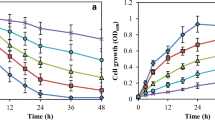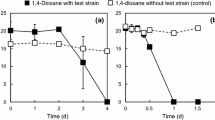Abstract
This study evaluated substrate interactions during the aerobic biodegradation of 1, 4-dioxane and BTEX mixtures by a pure culture, Acinetobacter baumannii DD1, which is capable of utilizing 1, 4-dioxane for growth. A. baumannii DD1 could utilize BTEX as a sole carbon source, but could not utilize m-xylene and p-xylene. In binary mixtures, there was a lag of about 14 h before the degradation of BTE, and 1, 4-dioxane only started to be utilized when BTE was completely degraded by 1, 4-dioxane-grown DD1. Furthermore, the biodegradation rate of 1, 4-dioxane decreased from 73.33 to 40.74 mg/(h g dry weight) after the biodegradation of benzene. 1, 4-dioxane could not be degraded after the biodegradation of o-xylene in 80 h. DD1 could also not degrade m-xylene and p-xylene coexisting with 1, 4-dioxane. The ability of DD1 to degrade BTEX occurred in the following order: benzene > ethylbenzene > toluene > o-xylene > m-xylene = p-xylene. The biodegradation of 1, 4-dioxane was not activated in the mixture with o-xylene, primarily because of the accumulation of the specific toxic intermediate, 2, 3-dimethylphenol. The lag in BTE degradation was presumably because of the induction of enzymes necessary for BTE degradation. Additionally, SDS-PAGE analysis demonstrated that there were different proteins during the degradation of benzene and 1, 4-dioxane.






Similar content being viewed by others
References
Agency for Toxic Substances and Disease Registry (ATSDR) (2012) Toxicological profile for 1, 4-dioxane. United States Department of Health and Human Services, Public Health Service, Atlanta http://www.atsdr.cdc.gov/toxprofiles/tp.asp?id=955&tid=199. Accessed 1 Oct 2012
Bernhardt D, Diekmann H (1991) Degradation of dioxane, tetrahydrofuran and other cyclic ethers by an environmental Rhodococcus strain. Appl Microbiol Biotechnol 36:120–123
Burback BL, Perry JJ (1993) Biodegradation and biotransformation of groundwater pollutant mixtures by Mycobacterium vaccae. Appl Environ Microbiol 59:1025–1029
Cai TM, Chen LW, Ren Q, Cai S, Zhang J (2011) The biodegradation pathway of triethylamine and its biodegradation by immobilized Arthrobacter protophormiae cells. J Hazard Mater 186:56–66
Deeb RA, Hu HY, Hanson JR, Scow KM, Alvarez-Cohen L (2001) Substrate interactions in BTEX and MTBE mixtures by an MTBE-degrading isolate. Environ Sci Technol 35:312–317
Duangduan Y, Voravit C, Thanomsak B, Pensri W, Herbert FH (2008) Characterization and health risk assessment of volatile organic compounds in gas service station workers. Environ Asia 2:21–29
Grazia B, Paola B, Enrica G, Stefano T (1987) Isolation of a Pseudomonas stutzeri strain that degrades o-xylene. Appl Environ Microbiol 53:2129–2132
Huang HL, Shen DS, Li N, Shan D, Shentu JL, Zhou YY (2014) Biodegradation of 1, 4-dioxane by a novel strain and its biodegradation pathway. Water Air Soil Pollut 225:2135–2146
Kahru A, Pollumaa L, Reiman R, Ratsep A, Liidera M, Maloveryan A (2000) The toxicity and biodegradability of eight main phenolic compounds characteristic to the oil-shale industry wastewaters: a test battery approach. Toxicology 15:431–442
Kenneth FR, Douglas CM, Julia DBR (2000) Biodegradation Kinetics of benzene, toluene, and phenol as single and mixed substrates for Pseudomonas putida F1. Biotechnol Bioeng 69:385–400
Kim YM, Jeon JR, Murugesan K, Kim EJ, Chang YS (2009) Biodegradation of 1, 4-dioxane and transformation of related cyclic compounds by a newly isolated Mycobacterium sp. PH-06. Biodegradation 20:511–519
Kim SJ, Park SJ, Cha IT, Min D, Kim JS, Chung WH, Chae JC, Jeon CO, Rhee SK (2014) Metabolic versatility of toluene-degrading, iron-reducing bacteria in tidal flat sediment, characterized by stable isotope probing-based metagenomic analysis. Environ Microbiol 16(1):189–204
Kunapuli U, Lueders T, Meckenstock RU (2007) The use of stable isotope probing to identify key iron-reducing microorganisms involved in anaerobic benzene degradation. ISME J 1(7):643–653
Li MY, Mathieu J, Yang Y, Fiorenza S, Deng Y, He ZL, Zhou JZ, Alvarez PJJ (2013) Widespread distribution of soluble di-Iron monooxygenase (SDIMO) genes in arctic groundwater impacted by 1, 4-dioxane. Environ Sci Technol 47:9950–9958
Liou JC, DeRito C, Madsen E (2008) Field-based and laboratory stable isotope probing surveys of the identities of both aerobic and anaerobic benzene-metabolizing microorganisms in freshwater sediment. Environ Microbiol 10(8):1964–1977
Lowry OH, Rosebrough NJ, Farr AL, Randall RJ (1951) Protein measurement with the folin phenol reagent. J Biol Chem 193:87–98
Mahendra S, Alvarez-Cohen L (2006) Kinetics of 1, 4-dioxane biodegradation by monooxygenase-expressing bacteria. Environ Sci Technol 40:5435–5442
Mahendra S, Petzold CJ, Baidoo EE, Keasling JD, Alvarez-Cohen L (2007) Identification of the intermediates of in vivo oxidation of 1, 4-dioxane by monooxygenase-containing bacteria. Environ Sci Technol 41:7330–7336
Mahendra S, Grostern A, Alvarez-Cohen L (2013) The impact of chlorinated solvent co-contaminants on the biodegradation kinectics of 1,4-dioxane. Chemosphere 91(1):88–92
Marion M, Holger F, Stefan K, Gerd UB, Eyk H, Mario S (2002) Determination of naturally occurring MTBE biodegradation by analysing metabolites and biodegradation by-products. Appl Environ Microbiol 87:37–53
Nakamiya K, Hashimoto S, Ito H, Edmonds JS, Morita M (2005) Degradation of 1, 4-dioxane and cyclic ethers by an isolated fungus. Appl Environ Microbiol 71:1254–1258
Noguchi M, Kurisu F, Kasuga I, Furumai H (2014) Time-resolved DNA stable isotope probing links desulfobacterales-and coriobacteriaceae-related bacteria to anaerobic degradation of benzene under methanogenic conditions. Microbes Environ 29(2):191
Oka A, Phelps C, McGuinness L, Mumford A, Young L, Kerkhof L (2008) Identification of critical members in a sulfidogenic benzene-degrading consortium by DNA stable isotope probing. Appl Environ Microbiol 74(20):6476–6480
Parales RE, Adamus JE, White N, May HD (1994) Degradation of 1, 4-dioxane by an actinomycete in pure culture. Appl Environ Microbiol 60:4527–4530
Prenafeta-Boldú FX, Vervoort J, Grotenhuis JTC, Groenestijn JW (2002) Substrate interactions during the biodegradation of Benzene, Toluene, Ethylbenzene, and Xylene (BTEX) Hydrocarbons by the Fungus Cladophialophora sp. Strain T1. Appl Environ Microbiol 68(6):2660–2665
Sala-trepat JM, Evans WC (1971) The meta cleavage of catechol by Azotobacter species 4-oxalocrotonate pathway. Eur J Biochem 20:400–413
Sei K, Miyagaki K, Kakinoki T, Fukugasako K, Inoue D, Ike M (2013) Isolation and characterization of bacterial strains that have high ability to degrade 1, 4-dioxane as a sole carbon and energy source. Biodegradation 24:665–674
Shim H, Yang ST (1999) Biodegradation of benzene, toluene, ethylbenzene, and o-xylene by a coculture of Pseudomonas putida and Pseudomonas fluorescens immobilized in a fibrous-bed bioreactor. J Biotechnol 69:99–112
Sugiura T, Ogawa H (2009) Thermodynamic properties of solvation of aromatic compounds in cyclohexane, heptane, benzene, 1,4-dioxane, and chloroform at 298.15K. J Chem Thermodyn 41:1297–1302
Sun W, Cupples AM (2012) Diversity of five anaerobic toluene-degrading microbial communities investigated using stable isotope probing. Appl Environ Microbiol 78(4):972–980
Sun W, Xie S, Luo C, Cupples AM (2010) Direct link between toluene degradation in contaminated-site microcosms and a Polaromonas strain. Appl Environ Microbiol 76(3):956–959
Sun WM, Sun XX, Cupples AM (2012) Anaerobic MTBE degrading microorganisms identified in wastewater treatment plant samples using stable isotope probing. Appl Environ Microbiol 78:2973–2980
Sun W, Sun X, Cupples AM (2014) Identification of Desulfosporosinus as toluene-assimilating microorganisms from a methanogenic consortium. Int Biodeterior Biodegrad 88:13–19
Vogt C, Kleinsteuber S, Richnow HH (2011) Anaerobic benzene degradation by bacteria. Microb Biotechnol 4(6):710–724
Young-Sook O, Zarook S, Basil CB, Richard B (1994) Interactions between benzene, toluene, and p-Xylene (BTX) during their biodegradation. Biotechnol Bioeng 44:533–538
Zeyer J, Wasserfallen A, Timmis KN (1985) Microbial mineralization of ring-substituted anilines through an ortho-cleavage pathway. Appl Environ Microbiol 50:447–453
Zhang XQ, Feng HJ, Shan D, Shentu JL, Wang MZ, Yin J, Shen DS, Huang BC, Ding YC (2014) The effect of electricity on 2–fluoroaniline removal in abioelectrochemically assisted microbial system (BEAMS). Electrochim Acta 135:439–446
Zhou YY, Chen DZ, Zhu RY, Chen JM (2011) Substrate interactions during the biodegradation of BTEX and THF mixtures by Pseudomonas oleovorans DT4. Bioresour Technol 102:6644–6649
Zhu L, Zhou JH, Lv ML, Yu HT, Zhao H, Xu XY (2015) Specific component comparison of extracellular polymeric substances (EPS) in flocs and granular sludge using EEM and SDS-PAGE. Chemosphere 121:26–32
Acknowledgments
This work was financially supported by the Fundamental Research Funds for Zhejiang Gongshang University [3100XJ1514154].
Author information
Authors and Affiliations
Corresponding author
Rights and permissions
About this article
Cite this article
Zhou, Y., Huang, H. & Shen, D. Multi-substrate biodegradation interaction of 1, 4-dioxane and BTEX mixtures by Acinetobacter baumannii DD1. Biodegradation 27, 37–46 (2016). https://doi.org/10.1007/s10532-015-9753-2
Received:
Accepted:
Published:
Issue Date:
DOI: https://doi.org/10.1007/s10532-015-9753-2




